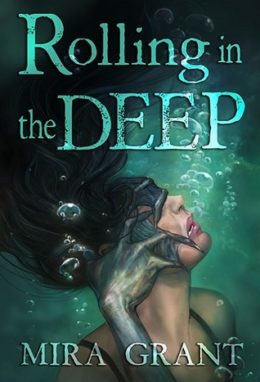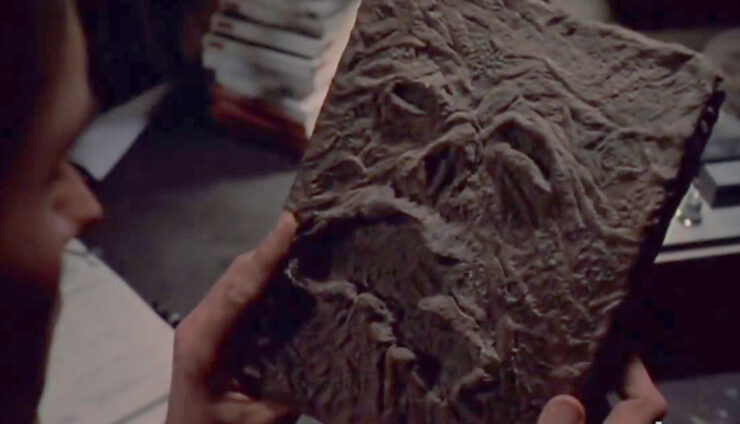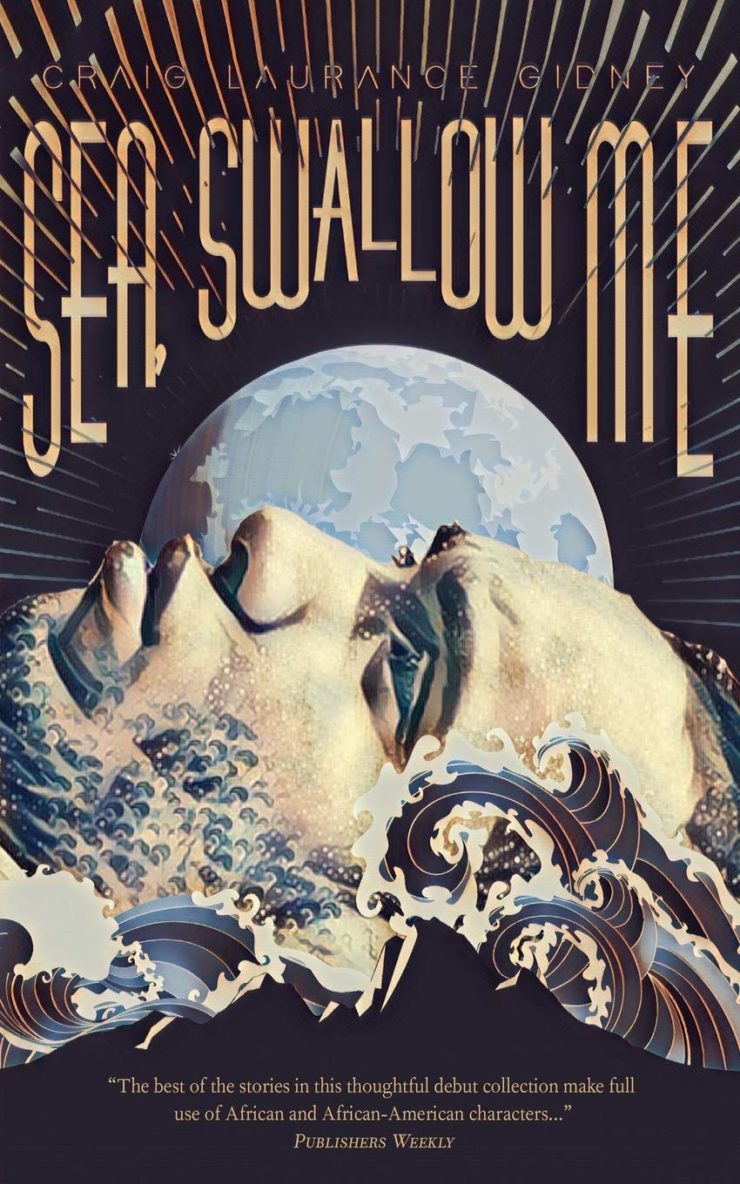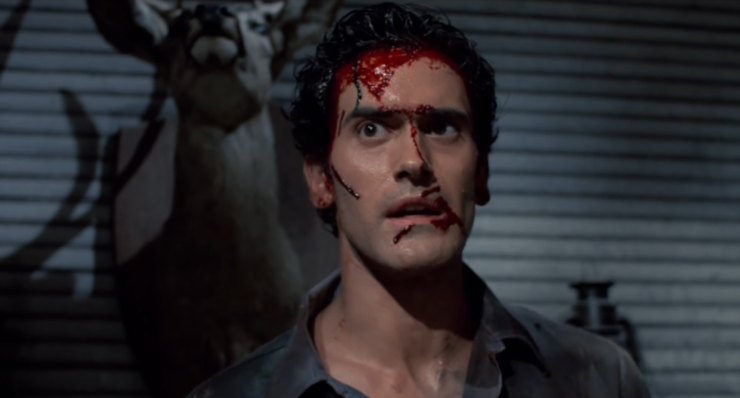Welcome back to the Lovecraft reread, in which two modern Mythos writers get girl cooties all over old Howard’s sandbox, from those who inspired him to those who were inspired in turn.
Today we’re looking at Mira Grant’s (a.k.a. Seanan McGuire’s) Rolling in the Deep, first published as a standalone novella by Subterranean Press in 2015. Spoilers ahead.
“We may never know how much of the footage from the SS Atargatis was faked, or how much of it was real.”
Summary
The Imagine Network built a core audience with B-movies, SF classics and well-received original series. Then it launched a block of “hyper-reality programming,” documentaries that judiciously blended fiction and fact. After initial skepticism, Imagine’s ratings climbed. Then came the Atargatis affair.
In May 2015, the cruise ship Atargatis launches for isolated waters above the Mariana Trench. Anne Stewart, Imagine correspondent, describes its mission as the ship sails into a photogenic sunset: “Some of the world’s best minds have been assembled…to answer, once and for all, the question that has plagued mankind since we first took to the seas. Are mermaids the hallucinations of lonely sailors? Or are they real?”
The scientists include an algae expert, a molecular biologist, a marine chemist, a deep-sea cartographer, a cetologist (whale, dolphin and porpoise expert), and an ichthyologist. None are aboard to seek mermaids—Imagine has lured them with the opportunity to pursue their own research while providing sound bites for the documentary. Captain Jovanie Seghers and crew are in it for a well-paid six week cruise to nowhere; their concern isn’t mermaids but keeping camera crews, scientists, and performers from destroying the ship or killing themselves.
The performers? If you count Anne Stewart, there are a dozen. The rest are professional swimmers who happen to wear neoprene fishtails—the Blue Seas Mermaids. Their job’s to flit through the Pacific at the edge of the cameras’ fields of view, just in case no real mermaids show up.
The Atargatis reaches its remote destination without incident. Camera crews start filming. Anne schmoozes the scientists as they gather samples and drop probes. One probe, designed to collect water at varying depths, resurfaces with a tube of red liquid. Algae? Oxidized iron? Blood? Blood it is, but the sample has characteristics both of fish and mammals. Could it come from a creature unknown to science? Anne presses. Ichthyologist Peter Harris is afraid so.
The next day a sailor’s missing; he had earlier heard the sea singing lullabies, and seen strange green lights dancing in the waves. During the Blue Seas troupe’s morning swim, one dives deep. Too deep—she never resurfaces, and rescue divers find nothing. Reactions range from devastated (her fellow pseudo-mermaids) to sobered, but work goes forward.
Peter Harris lowers his deep-water camera. Approaching the Mariana Trench, it picks up the expected bathypelagic creatures: a gulper eel, squid, bioluminescent fish. Then Anne notices a rising aura of greenish light.
What happens next shocks everyone. A hand reaches out of the blackness and blocks the camera lens: four-fingered, webbed, clawed, but undeniably a hand. It moves, revealing a glimpse of face. Then the camera jerks downward, goes dead. Molecular biologist Anton Matthews activates the winch that will haul the camera up, insisting Imagine’s pulling a stunt.
Peter replays the image of the face. Its nose is two slits. Its eyes are glowing green spheres. Behind disturbingly human lips, its mouth’s filled with needled teeth. And its hair—a black cloud of thick strands, each glowing green at the tip. Anne pushes the scientists for an answer: At night, say, with such a creature bobbing in the waves, could a sailor mistake it for the kind of mermaid famed in folklore?
Peter’s coming to an equivocal yes when the camera slams into the winch, hissing. That is, the stowaway it’s brought along hisses. Seen whole, in sunlight, there’s no doubt: the creature has a humanoid face and upper body, with a piscine lower body. The tail’s more like an eel’s than a dolphin’s, long and slimy with tattered vertical flukes. As they gawp, it stares right back, the green sparks in its hair—tentacles?—flashing.
Anton recovers first, and laughs. Imagine has outdone itself for special effects this time! What’s the thing made of, anyway? He approaches the mermaid, hand extended.
It bites off his fingers. Then his face. Then drags him overboard.
Panic ensues. Some run to a Captain Seghers already dealing with disaster: the Blue Seas mermaids took a memorial swim for their lost mate and are being devoured by monsters. Peter Harris sits by his camera as real mermaids swarm the ship, lost in wonder at this new species. When one approaches him, he speaks to it, and it mimics his words, even his voice. “You’re a miracle,” he tells it. “You’re a miracle,” it echoes, then delicately tears out his throat.
Anne, cameraman Kevin, and marine chemist Alexandra crowd into the control room with Captain Seghers, who’s struggling to get underway with her crew dying on every deck. Kevin reviews on-the-run footage showing that the mermaids all look identical. Alexandra pales, muttering about how deep-sea fish often show extreme sexual dimorphism, one female to hundreds of much smaller, identical males. Why are these ones taking bodies over the rails? To feed something? Something bigger?
She cowers to the floor. The unfortunate rest see into the water before the prow brighten, as if a vast green sun rises from the depths…
Six weeks later, the USS Danvers finds the Atargatis floating without guidance. No one’s aboard, living or dead. The Danvers investigates for three days, until strange lights and noises unnerve her crew.
In December 2017, the Imagine Network airs unedited footage recovered from the Atargatis, though it means paying fines to the FCC for excessive gore. Can there be any question about what really happened on the ship that last night? Its people were not lost. They were found.
What’s Cyclopean: The Atargatis is appropriately named after a Syrian fertility goddess, patron of fertility both landbound and aquatic. She’s sometimes supposed to have the form of a mermaid.
The Degenerate Dutch: The cast and crew of the Atargatis are realistically diverse, and the ableist jerk who signs on to harass women gets eaten first. For bonus points, we only have to spend a brief moment in his point of view before he gets pulled overboard.
Mythos Making: Terrifying aquatic humanoids automatically get membership in the Mythos club. You don’t wanna know what happens if you try to keep them out…
Libronomicon: The voyage of the Atargatis gives a whole new meaning to “publish or perish.”
Madness Takes Its Toll: Even if you’re about to die, you’re better off not looking.
Anne’s Commentary
In ancient times, Atargatis was the chief goddess of North Syria, Great Mother of Love and Fertility over the earth and waters. Apparently she’s sometime depicted with a fish tail for her lower body. In other words, as a mermaid. Certainly she had an affinity to fish, which were sacred to her, along with doves (because that Love thing.) So Mira Grant’s ship is aptly, if ironically, named.
The ship in Grant’s novel-length sequel Into the Drowning Deep, which I bought about five seconds after finishing this novella, is named the Melusine. In European folklore, Melusine is a spirit of rivers or springs, fish or serpent from the waist down. Sometimes she has wings. Sometimes she has two tails. Holy Starbucks, that would be an awesome mutation for a strain of Grantesian mermaids, two long slimy eel tails each!
Though, from a selfish and self-preserving land human point of view, forget it. They do enough damage with one tail.
And now that we’re talking doing damage, I’m in just the drug-induced loopy mood (due to a retrogenetic hip problem from being a German shepherd in some previous life) to play What If It Was A Fight Between. I learned this game from the coolest psychology intern ever, who would slouch into my office and, apropos of nothing, ask, “What if it was a fight between Dr. X and Dr. Y?” Drs. X and Y being two very prominent psychiatrists in our hospital, of course. To which I would respond: “Dr. X would kick his ass.” Intern: “What if Dr. Y had a knife?” Me: “Dr. X always carries a derringer in her lab coat pocket.” And so on, up to the nuclear option on a good day.
Way back in August of 2016, we read Seanan McGuire’s “Down, Deep Down, Below the Waves,” which features amphibious marine humanoids with an East Coast hometown of Innsmouth, Massachusetts, who worship Dagon. Yeah, Deep Ones. I understand that Ms. McGuire and Ms. Grant are thick as thieves, so I imagine that Grant’s mermaids are a sort of answer to McGuire and Lovecraft’s aquatic race. Like, Grant and McGuire were sitting around drinking tea and serving as cat cushions, and Grant said “You know, Deep Ones aren’t scary enough. What if I invent a water species that could give them nightmares?” McGuire: “Sure, go for it.”
And so, meet the Ariels from hell. But like Pickman’s ghouls and the Elder Things of Antarctica, they’re rendered with a richness and precision of detail worthy of a biologist describing a…a…creature never before encountered by Science! And so they’re worthy to go up against Lovecraft’s great fish-frogs!
What if it was a fight between Deep Ones and Mermaids (Grant variation)?
ME ONE: Like, an equal number of each? And where?
ME TWO: You always make things so difficult. Five of each. In the middle of the ocean.
ME ONE: Which ocean? Because if like the Atlantic off North America, the Deep Ones have the advantage of being near Y’ha-nthlei.
ME TWO: Okay, the Pacific. Equidistant between the Mariana Trench and R’lyeh, so fair.
ME ONE: Why are they fighting?
ME TWO: Shut up. Because it’s their first night at Fight Club, and you have to fight.
ME ONE: No, because they could be allies. They could both worship Dagon and Hydra.
ME TWO: They aren’t. They don’t. Only one apex sapient can rule the sea.
ME ONE: I don’t accept that postulate. Anyway, can they have weapons?
ME TWO: Look, they were all out for a nice swim, okay, and met accidentally. They left their tridents at home.
ME ONE: Who has tridents?
ME TWO: Just everybody down there, check out your classical tritons and the Emrys Deep Ones, but not these guys right now, okay? It’s bare claws on bare claws. And teeth. Mermaids have awesome teeth. They wrap their tails around the Deep Ones and bite off their Innsmouth looks. Mermaids for the win.
ME ONE: Deep Ones were walking shoggoths. Shoggoths suck the Mermaids’ heads off.
ME TWO: Mermaids call for that huge light-emitting thing that attacks the Atargatis. It swallows the shoggoths for breakfast.
ME ONE: Shoggoths in the huge thing’s gut summon the Protoshoggoth. It devours huge thing. Deep Ones win.
ME TWO:
ME ONE: Whaaaat???
ME TWO: I can’t believe you played the Protoshoggoth card again.
More seriously, Grant’s “mermaids” give ample proof of their physical prowess in this introductory novella, but only hints of a mental capacity and sophistication to match that of Lovecraft’s Deep Ones. I won’t drop any spoilers, but for those intrigued by this addition to the undersea neomythology, Into the Drowning Deep expands on Mermaid mentation and social structure while (yes, it’s possible) upping the fear factor!
Ruthanna’s Commentary
On my way back from Wiscon in 2012, I dropped a friend off in Chicago. (The same friend who knit me a Yith, for those keeping track of these things.) During the half hour we spent at her house I was continually distracted from our conversation—I was boggling at the ostensible “documentary” that her mother had on the television. The show purported to prove the existence of mermaids, complete with CGI footage of the world’s nastiest-looking “aquatic ape” snarling at the camera. I mocked the thing on the way home, joined a couple of Twitter threads castigating the ostensibly scientific channel that hosted it, and promptly forgot about it. Trust Mira Grant, a.k.a. Seanan McGuire, to go a little further. Rolling in the Deep takes Animal Planet’s dubious-yet-profitable idea and runs with it, right into the deep end.
In addition to having way too much fun with the faux-documentary format, Rolling is a paean to horror movies. The structure is a familiar one: an engaging ensemble cast sets off on an innocent fill-in-the-blank, only to be horrifically killed one by one until… well, McGuire has dealt with the Final Girl elsewhere. No one on the Atargatis gets that lucky.
The general rule for horror movies is that you have to have done something to deserve your grisly fate, for definitions of “deserve” that have more to do with faerie-style poetic justice than ordinary mortal opinion. Check out that deserted house that everyone avoids, for example, or make fun of the unpopular girl with no social skills but a surprising talent for telekinesis. All too often, it doesn’t take more than sneaking off to the woods with your boyfriend. The passengers and crew of the Atargatis have committed a much worse violation: making reality TV. In the service of entertainment—as well as pride, funding, and tenure–the researchers have agreed to violate the core requirement of science: to tell the truth about what they find. It’s only appropriate, then, when their lies turn out to be all too true!
I adore this take on scientific horror. All too often, scientists in horror stories are punished for not being genre-savvy enough—essentially, for acting like they’re in a science fiction novel where it would be perfectly reasonable to investigate that new life form. (Michael Crichton, I am looking at you.) Here, the narrative approves of research, and the sin lies is not being scientific enough. Even there, we’re well aware that these sins take place every day in academia, just usually with less getting eaten by mermaids.
On the flip side, there’s more than punishment going on. Most of the characters die being quintessentially themselves. David dies trying to communicate. Jovanie dies at her helm. We’re told up front that some of them—Peter with his delight in the creature’s biology, the mermaid troupe swimming in their chosen element—would choose to die this way.
I do love this cast, with all their varied orientations and abilities and vivid personalities, all illustrated vividly enough to get me attached every readthrough, even knowing they’re all gonna die. I would happily read the alternate SF version of this book in which they all go home and get fabulous publications out of the trip, too.
Our last McGuire piece also included aquatic humanoids and dubious scientific ethics. These ones are less directly tied to the Mythos, but there’s something intrinsically Lovecraftian about aquatic horror. The ocean was perhaps one of Lovecraft’s more rational terrors—a vast unknown dimension, intrinsically deadly to human existence, and endlessly fascinating in the improbable creatures that occasionally wash up on the edges of our perception. We can’t help but be drawn to it, and can’t be surprised when it’s deadly.
Next week, we go back to find some pre-Lovecraftian New England horror in Mary Wilkins Freeman’s “Luella Miller.”
Ruthanna Emrys is the author of the Innsmouth Legacy series, including Winter Tide and Deep Roots (available July 2018). Her neo-Lovecraftian stories “The Litany of Earth” and “Those Who Watch” are available on Tor.com, along with the distinctly non-Lovecraftian “Seven Commentaries on an Imperfect Land” and “The Deepest Rift.” Ruthanna can frequently be found online on Twitter and Dreamwidth, and offline in a mysterious manor house with her large, chaotic household—mostly mammalian—outside Washington DC.
Anne M. Pillsworth’s short story. “The Madonna of the Abattoir” appears on Tor.com. Her young adult Mythos novel, Summoned, is available from Tor Teen along with sequel Fathomless. She lives in Edgewood, a Victorian trolley car suburb of Providence, Rhode Island, uncomfortably near Joseph Curwen’s underground laboratory.














